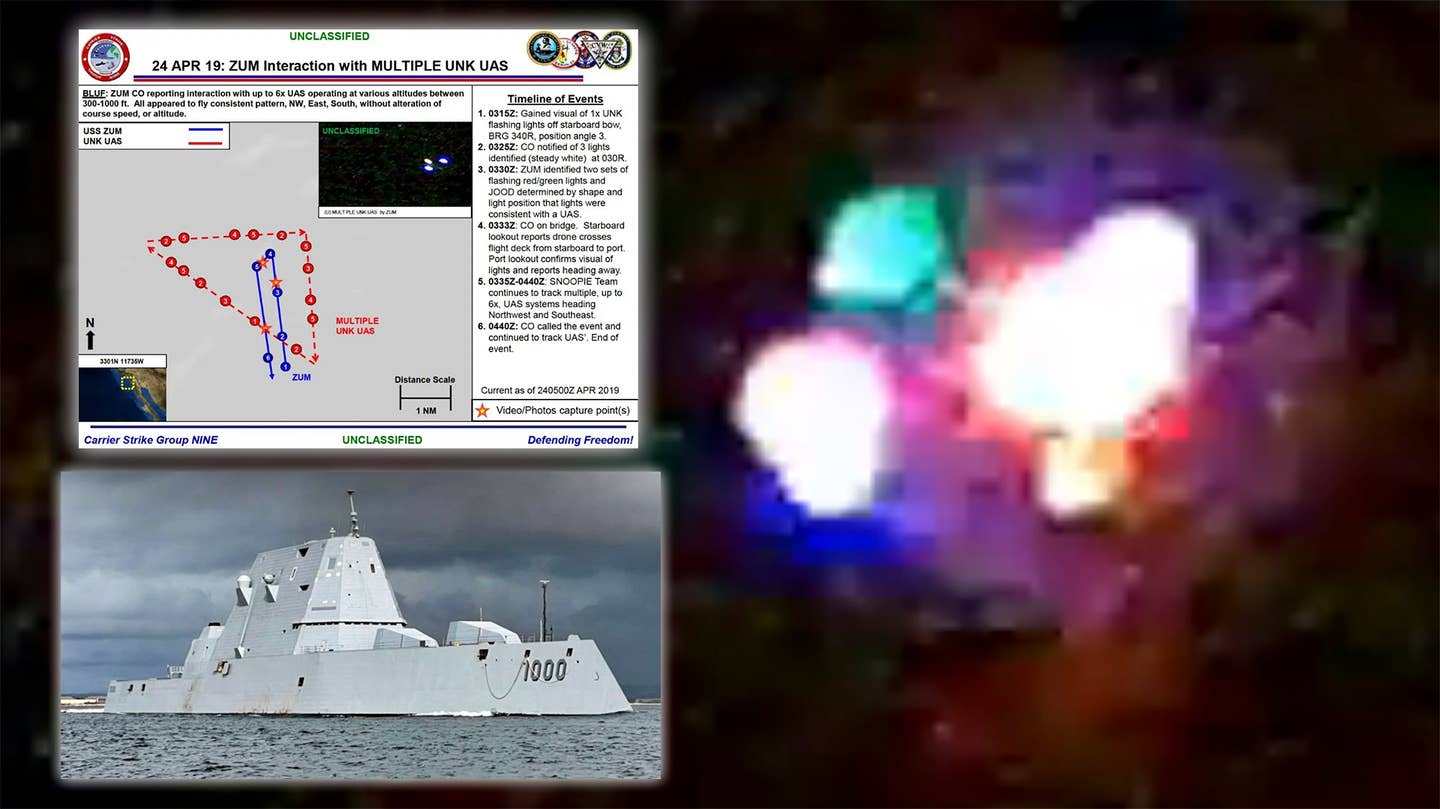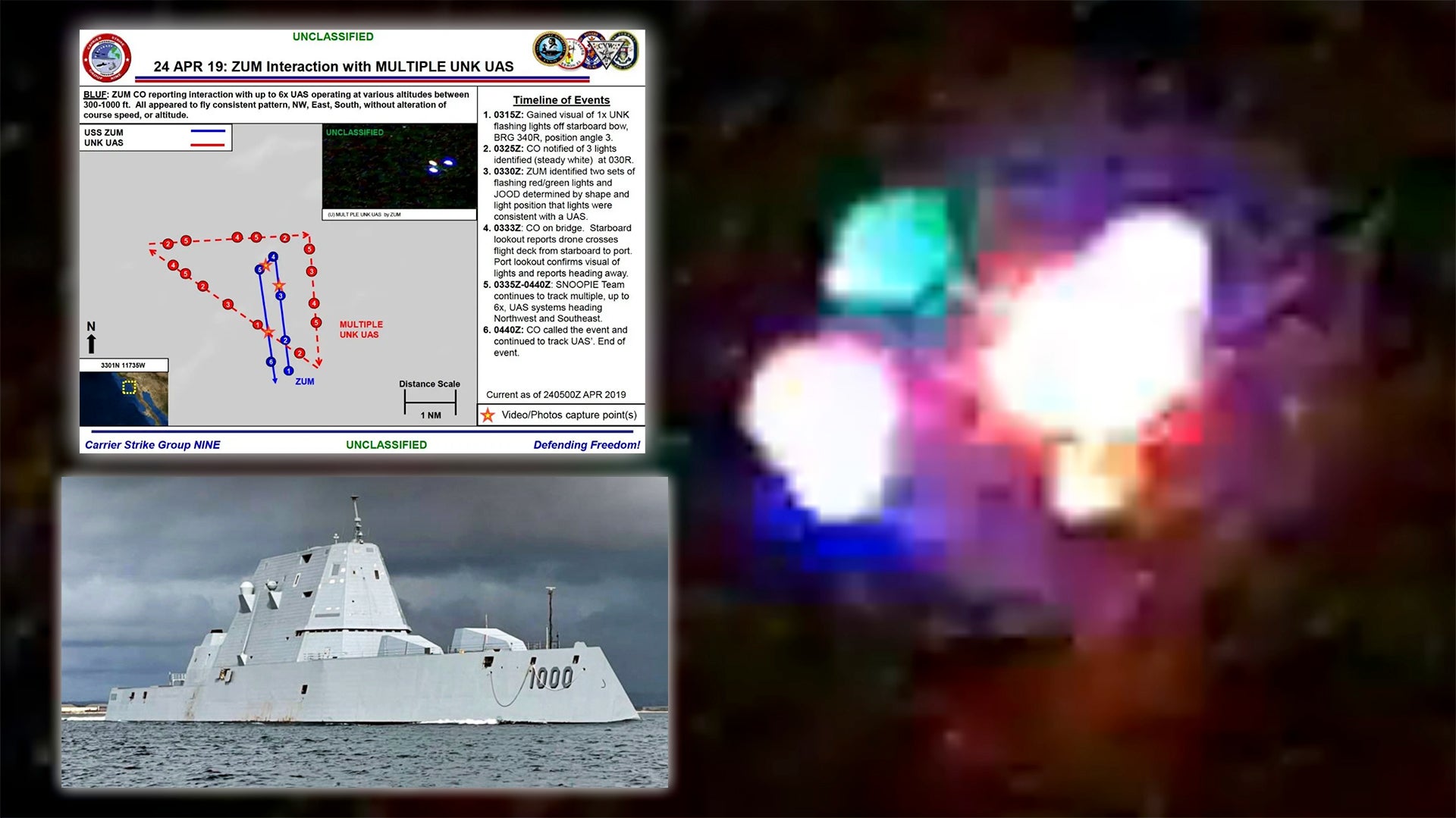The swarm incident involving USS Zumwalt was just one of many similar events involving Navy ships off California in 2019.

The U.S. Navy has released a new video from an incident that involved six unidentified drones flying over its most advanced surface combatant, the USS Zumwalt. The incident occurred in the waters off the coast of Southern California in April 2019.
The War Zone received the video via the Freedom of Information act as part of our ongoing investigation into reports of drone swarm incidents that occurred near Navy vessels intermittently throughout 2019 off Southern California. Our previous update in the investigation produced a number of briefing documents, including an unclassified video and photographs that provided a significant increase in detail about these strange incidents. While the bulk of the drone swarm events occurred in July of 2019, we learned of several new events that occurred earlier in the year. Among these was the incident involving the USS Zumwalt.
The incident occurred at approximately 8:30 PM Pacific Time on April 24th 2019, around 17 nautical miles from the Marine Corps base at Camp Pendleton in international waters. During the event, the USS Zumwalt reported that as many as six unknown unmanned aerial systems (UAS) were seen operating nearby at altitudes ranging from 300 to 1000 feet. At one point in the incident, the UAS reportedly crossed over the deck of the USS Zumwalt. As in similar past incidents, the drones were documented by the Ship Nautical Or Otherwise Photographic Interpretation and Exploitation team, or “SNOOPIE team.” These sailors essentially act to document dangerous, uncertain, or unusual situations using a variety of commercial-grade cameras.
You can view the newly obtained footage from the incident and listen to a sailor’s accompanying narration here:
A briefing slide and photograph from the incident was previously published by The War Zone, and is shown again below:
It should be noted that the USS Zumwalt (DDG-1000) is a unique vessel as the lead ship in its class of controversial, but technologically advanced stealthy surface combatants. The ship’s stealth technology is designed to allow it to be more survivable than other destroyers, including being able to operate closer to enemy territory during certain operations.
Detailed analysis of the low-resolution video is difficult given that it was taken at night. While unclassified records released to the public tend to be underwhelming, it is likely that the USS Zumwalt had access to a range of sophisticated sensors during the incident.
The only clear feature in the video is a set of several lights in a rectangular formation. The lights appear to be white and green, with an intermittently blinking red light presumed to be in the center of the object. A sailor comments that the UASs do not appear to be armed in the narration.
For further analysis, we spoke with David Kovar, CEO of URSA Inc. Kovar’s firm specializes in drone security issues, including criminal investigations and UAV threat management. Kovar stated that “I’m unable to determine much of the configuration of the aircraft. It appears to have four regularly spaced running, or navigation lights.”
Kovar stated that given the context of the narration and the briefing slide, the object could be a “multi-rotor, likely a quad, UAV with running lights.” However, he noted that this assessment is based on a typical configuration of quadcopter lights. He stated that while the video could match other objects, as well, given the lack of detail in the video, it appears consistent with the description of a UAS in the narration and the briefing slide. Of course, other potential types exist, including smaller gasoline-powered fixed-wing types that pack long ranges or hybrid types that can takeoff and land vertically but are more efficient in forwarding flight with the help of a pusher propeller and wing-like appendages. The latter has become a favorite of the Chinese Navy.
A former drone industry analyst who declined to be named due to their current employment highlighted several other features of interest. The analyst commented that “while the video isn’t of the best quality, I don’t see anything on the drone that would make me think it’s something that couldn’t be purchased off the shelf from a current commercial drone manufacturer.” The analyst added, “the fact that the narrator said that there was a pattern of flight where there were no changes in altitude tells me that the drones were either programmed to fly a certain route or controlled from a distance while possibly on altitude hold, which to me isn’t the hallmark of any advanced technology.”
They further commented, “what is interesting is that they reported 6 drones and they were 17 miles off the coast of Southern California. This tells me that these drones were likely launched from a boat and that this was likely a planned ‘mission’ because no one has 6 drones on a boat for recreational purposes.” The analyst further stated that physically capturing the drone “is really the only way a forensic assessment can be made to determine the origin and capabilities associated with an [unidentified] drone.”
The observation of bright lights on unidentified UAS has been a recurring feature in several of the other drone swarm incidents we have investigated. In a previous interview, DroneSec CEO Mike Monnik told The War Zone that his firm’s database of drone incidents has registered an uptick in swarm events, and that in some cases less capable drones are used as “canaries” that intentionally distract or probe the defense of a potential target. There is also a long Cold War history of technologies designed to intentionally stimulate air defense systems in order to capture valuable signals intelligence, which you can read more about here.
As in the other drone swarm cases from this general area and timeframe, several key questions remain unanswered. Based on the briefing slide above, we have reached out to Carrier Strike Group Nine to inquire if the operator of the drones was ever positively identified, or if any effort was made to track the drones to their ultimate destination. They have not responded at the time of writing. The Chief of Naval Operations Michael Gilday previously stated that the Navy did not get to the bottom of similar incidents that occurred in the same region later in the same year. In a congressional hearing earlier this year, representatives of the Navy and Department of Defense explained that several of the incidents were in fact related to drone swarms, but did not offer further details.
While details about these incidents have been difficult to come by, drone swarms are becoming a general area of increasing interest for the Navy. Just in the last month, the Naval Surface Warfare Center Crane Division ran an event called “Silent Swarm 22.” Conducted at ranges with the Michigan National Guard’s National All-Domain Warfighting Center, this was a “large scale experimentation event” that brought together over 150 participants to focus on “Electromagnetic Warfare (EW) employed on small multi-domain unmanned systems (UxS).”
Notably, the logo, seen below, for the event depicts a warship surrounded by a web and a swarm of various fixed-wing and rotor-wing drones. Reflections of the drones can be seen in the water, perhaps a nod to the “multi-domain” reference and the more inclusive UxS acronym in the event’s description.
This is just one of a number of major Navy exercises focusing on unmanned systems, and those efforts are only accelerating and have been for years
While the Navy focuses on forward-looking efforts to employ drone swarms, it is not the only player in this space. The string of drone swarm incidents throughout 2019 demonstrates that surveillance of key naval assets is being conducted in the areas where they train – often within miles of the American coast. Drone swarms are not a theoretical emerging technology threat, but rather a present tense reality. U.S. adversaries are openly developing and deploying these capabilities and all indications point to the fact that networked swarms of lower-end drones will be absolutely critical to prevailing in future high-end maritime conflicts.
The inherent difficulty of reliably detecting, tracking, and countering drones has created a unique challenge for the Pentagon in recent years. In fact, it is among the department’s biggest tactical and strategic concerns. The often ambiguous footage from incidents has led to an overlap of the drone issue with longstanding cultural interest in UFOs – a dilemma that The War Zone has reported on for some time. Disambiguating drone surveillance incidents from headier claims appears to be a priority of lawmakers, though it remains to be seen how the Department of Defense will make such distinctions in practice.
Perhaps more importantly, it remains to be seen how effective the Navy and Department of Defense will be in investigating and resolving these incidents in an era when once considered highly advanced drone technology is becoming increasingly sophisticated and accessible.
Update 9/1/22:
We reached out to DroneSec, a drone security intelligence firm based in Melbourne, for their comment on the video from the USS Zumwalt incident. Due to the time zone difference, we were not able to include their response before initial publication. DroneSec CEO Mike Monnik told us via email that “given the alleged unaltered speed and altitude, it was possibly on a preplanned route. Either this was enabled as the UAS approached the ship, or it was already conducting its preprogrammed route and the USS Zumwalt entered the area.” Monnik stated, “in our opinion, we don’t believe it is a fixed-wing given the slight visibility of the cross-section.” He also told us that the DroneSec team found visual similarities with the DJI Inspire, which also has lights in a box shape and a comparable LED light sequence. A video of the DJI Inspire operating at night can be seen below:
Note that given the clarity of the video, this is not a positive identification, but rather an estimate of the general type of drone that may have been employed. While LED light sequences can be helpful in identifying drones in some cases, there are significant limitations in drawing inferences based on this alone. Monnik emphasized that “UAS can often modify their own light sequence by color, frequency and speed,” and that these features are readily available in some commercially available drones.

MORE TO READ
